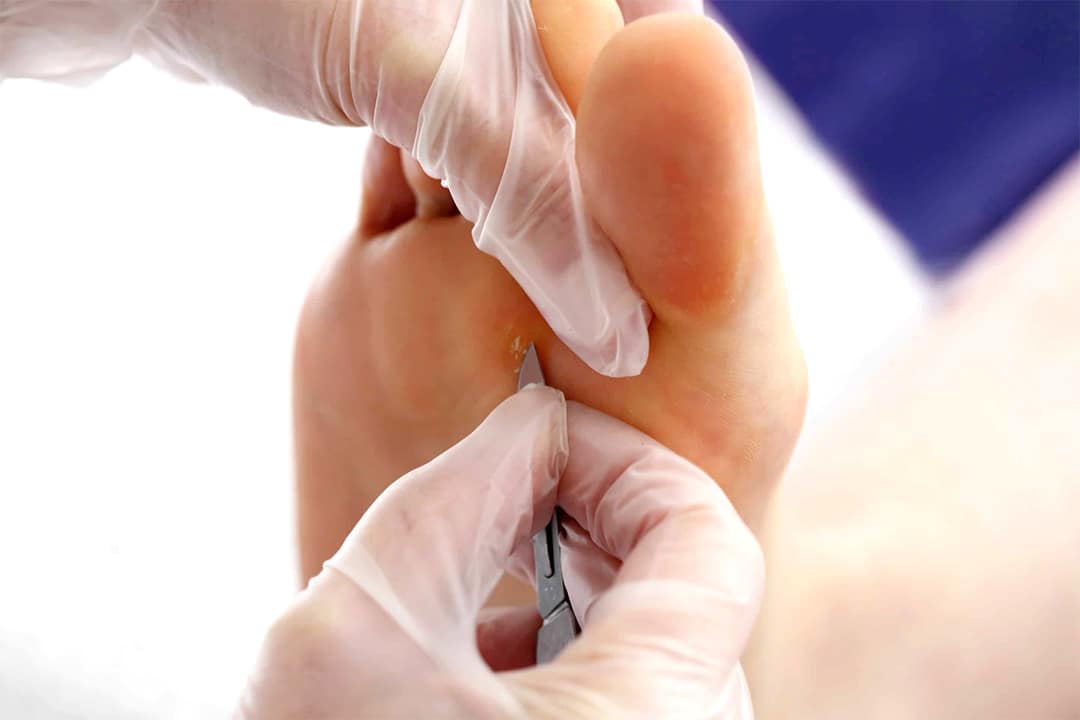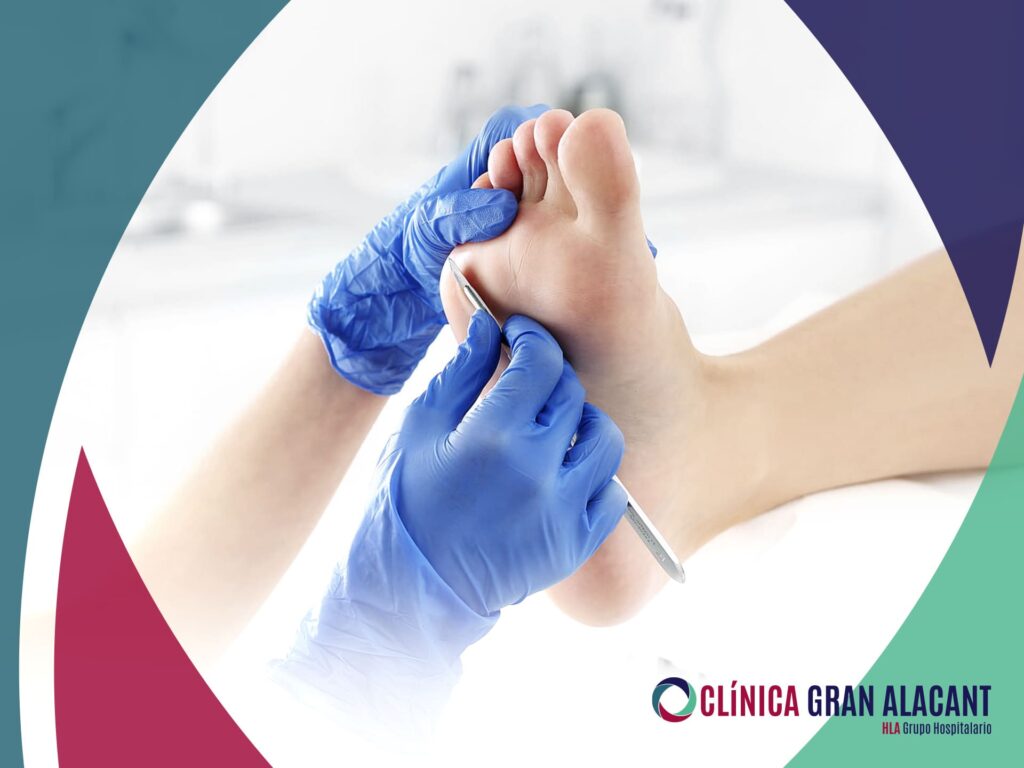What is a plantar callus?
From a technical point of view, a plantar callus refers to a type of small callus that forms on a bony spot. An affection also known as plantar corn, heloma molle or heloma durum. Plantar callus are extremely annoying and painful, so it is strongly recommended to seek treatment from a professional podiatrist.
In this article we are going to summarize as much information as possible about plantar callus: its characteristics, causes, symptoms and treatment.
Although many people resort to home remedies, the reality is that they rarely work. Plantar corn on the foot is extremely uncomfortable and requires treatment by a professional podiatrist in order to resolve it as quickly and effectively as possible.
Characteristics of plantar callus on the foot
The main characteristics are the following:
- Discomfort and pain.
- Location of the callus between the toes.
- Yellowish coloration.
- Round shape.
Another fundamental characteristic is that plantar callus usually appear between the toes, specifically between the fourth and fifth toes.
Symptoms of plantar callus
A heloma durum in the foot is usually accompanied by intense discomfort and pain in the area. If left untreated, the pain can become very intense and almost unbearable.
Pain is undoubtedly the most obvious symptom of the appearance of a fibrous corn in the foot, but it is not the only one.
Plantar callus usually have a quite distinctive morphology: they are large and round, and present a dark yellowish color on the skin. In addition, it is common for them to appear in the areas between the toes, hence the name interdigital heloma. They usually appear most frequently in the space between the fourth and fifth toes.
Causes of heloma durum
One of the main causes of heloma molles is the use of footwear that is too narrow or poorly adjusted to our plantar morphology. For this reason, and in order to avoid the formation of blisters due to friction between the bones of both toes, the skin tends to create this type of callus. Other common causes may be standing for too long or a bad alignment of the bone.
In this sense, one of the points that marks the problem of heloma durum is therefore the shoe. For this reason, we must be careful with the type of shoes we wear.
Difference between callus and plantar corn
There is often confusion between callus and corns. Although they may be similar, they have distinctive characteristics. First of all, corns are usually larger in size, mainly because plantar corn generally appear in a space between the toes, which is somewhat smaller than the frequent areas where corns appear. Corns tend to be more on the sides and soles of the feet.
On the other hand, corns are not painful, except if pressure is put on them. While platar corns are quite painful.
Ways to remove a plantar callus
Generally speaking, getting rid of a plantar callus will require the help of a professional podiatrist. Although there are home solutions you can try, they usually only provide temporary relief and do not solve the problem permanently.
Special dressings for plantar corn
You can find these special dressings or band-aids for plantar corn at any drugstore. They may provide temporary pain relief, but they do not solve the problem itself. Basically, they act as a kind of cushion that cushions and prevents rubbing and pressure on the affected area.
Plantar callus peel
The exfoliation of a plantar callus should only be performed by a specialized podiatrist. One of the main advantages is that it provides quick and significant pain relief. However, it is important to note that this relief is temporary and may last for a shorter or longer period of time. It is important to note that callus tend to recur if the underlying cause is not addressed definitively.
Removing a callus by surgery
Surgery is the safest, fastest and most effective way to definitively eliminate a plantar corns without the risk of it reappearing in the future.
It is important that this intervention is performed by specialized professionals, although it should be noted that it is a simple surgery, painless and without subsequent discomfort.
The procedure consists of intervening on the bone that causes the friction with the skin through a small incision. In this way, the rubbing between the toes is permanently eliminated.
Why do heloma molle form?
Heloma molle are mainly caused by the shoe rubbing against the skin. They are actually a protective response that our body develops to prevent the appearance of blisters on the skin.
The cause is usually the frequent use of narrow shoes that do not fit the shape of our feet. Our body reacts by generating these calluses to prevent the formation of blisters.
Heloma durum can also appear due to problems of alignment of the bones of the foot or by spending long periods of time standing. This is why it is common in certain jobs that involve maintaining a static position for hours at a time.

Tips to prevent heloma durum
To prevent the appearance of plantar callus, it is advisable to follow these tips:
- Wear shoes that fit perfectly to the shape of your foot, thus avoiding the appearance of annoying heloma molle.
- Avoid standing for longer than necessary in the same position. If it is necessary for your work, for example, look for solutions such as stools or try to move around a little from time to time.
- Moisturize the skin on your feet. Keeping the skin moisturized is crucial, as it helps to soften areas prone to chafing. If you spend many hours on your feet at work, for example, it’s a good idea to moisturize your skin regularly.
Treatment of heloma molle on the feet
It is essential to keep in mind that there is no set time in which heloma molles will disappear on their own. In fact, the option to eliminate them completely is surgery. If you opt for this alternative, you have to go to a professional podiatrist, since surgery is the most effective method to eliminate plantar corns.
If you are not comfortable with the surgery option, the podiatrist can treat the area affected by plantar corn through exfoliation and can also use silicone prostheses between the toes.
Do home remedies work?
There are several home remedies that can provide temporary relief from pain. However, as mentioned above, these only offer a temporary solution and do not address the problem permanently. We hope this information has been useful to you on your way to making decisions that will help you to improve your heloma molles, as well as the discomfort and unpleasant effects they cause. In any case, the best way to put an end to the problem of plantar callus in the foot is to seek the help of a professional podiatrist.
You will achieve more effective and lasting results by having the knowledge and experience of a podiatric specialist. The podiatrist will be able to evaluate your situation individually and recommend the most appropriate treatment to eliminate heloma molles for good.
Remember that the health of your feet is fundamental and directly affects your daily well-being. Do not hesitate to seek professional help if you suffer from plantar callus or other foot conditions that cause you discomfort.
Put your feet in expert hands and say goodbye to annoying heloma durum once and for all!



